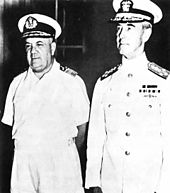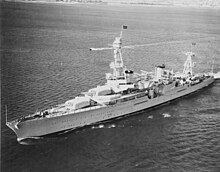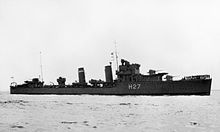ABDA fleet
The ABDA fleet ( English ABDA Sea or ABDAFLOAT or Allied Combined Striking Force or Allied Striking Force ) was a united multinational allied naval organization at the beginning of the Pacific War in World War II , which was made up of US , British , Dutch (English "Dutch") ) and Australian units ( A merican- B ritish- D utch- A ustralian). The declared aim of the naval association, created on January 8, 1942 and under the joint command of ABDACOM , was to stop the Japanese advance towards the British and Dutch colonies in Southeast Asia . After her defeat at the Battle of the Java Sea and the sinking of her flagship Mr. Ms. De Ruyter or the death of Rear Admiral Karel Doorman on February 28, 1942, it virtually ceased to exist.
history
This multinational naval force was simultaneously with the combined American-US - British - Dutch - (English: "Dutch") and Australian American-British-Dutch-Australian Command command ( A merican- B ritish- D utch- A ustralian Com mand) a month after the Japanese Attack on Pearl Harbor on January 8, 1942 established in defense of the British and Dutch colonies against the Japanese advance into Southeast Asia .
Basically, this also was Allied (Combined) Striking Force called Allied fleet from the in Dutch East Indies stationed ships and submarines of the Royal Netherlands Navy , the Asian fleet of US Navy (US Asiatic Fleet), stationed in Southeast Asia units of the British Royal Navy as well as some ships of the Australian Royal Australian Navy .
The supreme command of the ABDA fleet was initially held by the American Admiral Thomas C. Hart , whose Asian fleet with the heavy cruiser USS Houston as the flagship initially formed the core. Hart was replaced on February 12, 1942 by the Dutch Vice Admiral Conrad EL Helfrich . The headquarters of ABDACOM and the fleet were initially in Singapore , but on January 15, 1942, at the request of the Netherlands, they were relocated to Bandung on Java . The operational command at sea was initially held by the American Rear Admiral William A. Glassford , and from the end of January 1942 by the Dutch Rear Admiral Karel Doorman - his flagship was the light cruiser De Ruyter until the end .
But right from the start, this fleet association was not under particularly good omens, because there were two different languages (Dutch, English) and three different systems of flag signals within the four navies (Royal Navy / Royal Australian Navy - Koninklijke Marine - US Navy), what made communication between the ships difficult, especially at the beginning. In most cases, a communications officer was deployed on a ship, where all radio messages converged and who - translated if necessary - passed them on (during the last battle of the fleet, this officer sat on the British HMS Exeter , which was one of the first Ships was incapacitated). The English-speaking navies and the Dutch ships also kept their own communication channels, but as a rule most of them could not communicate autonomously via radio telegraphy with the flagship De Ruyter .
Apart from this rather organizational deficiency, the association lacked large units such as battleships (the destruction of British Force Z in Malay waters in 1941 was now all the more noticeable) and aircraft carriers . Instead, only a few heavy cruisers , some light cruisers and various lighter units such as destroyers , speedboats , gunboats and minesweepers were available. Although there were still a considerable number of Dutch submarines ready on paper , not all of them were ready for use, and the escort devices of the Japanese made their operations difficult. There were also various American submarines in use, but not all of them were stationed in the Dutch East Indies. On the other hand, there were very few British boats in the combat area.
What was even more serious, however, was the blatant shortage of aircraft, because there were only a few Dutch or British aircraft in the region, so that the ABDA fleet practically always had to operate without cover from the air and therefore had to resist the frequent air attacks by the The Japanese could hardly defend themselves effectively. It was not until the late phase of the fighting that the USA tried to increasingly move its own aircraft to the combat area after the fall of the Philippines . On January 26, 1942, the Japanese transport ship Sanuki Maru (9246 GRT) was sunk near Balikpapan during a US air raid with heavy Boeing B-17 bombers - one of the first attacks with B-17s .
Despite some successes, the ABDA fleet did not have a long life. The naval battle off Balikpapan on January 24, 1942, in which four destroyers of the ABDA fleet sank four Japanese troop carriers and a patrol boat and severely damaged two transport ships, brought the ABDA fleet the first and only major victory.
But already in the battle in the Strait of Makassar on February 4, 1942, Japanese dive bombers forced the fleet to break off their attack on the Japanese ships . The blatant shortage of Allied aircraft did the rest, because the air forces ABDA Air under the British Air Marshal Richard Peirse could only rarely intervene in the fighting, and more than once the ABDA fleet was retreated by Japanese air raids during initially promising missions forced.
In the sea battle in the Strait of Badung from February 18 to 20, 1942, the four Japanese destroyers succeeded in the course of the battle in defeating the numerically vastly outnumbered Allied forces and successfully defending the two transport ships for landing on Bali a destroyer was sunk, a destroyer and a cruiser damaged. The Japanese destroyers suffered only minor damage. Despite the use of three cruisers, seven destroyers, two submarines, seven speedboats and 20 aircraft, this operation on the Allied side was a blatant failure.
The only aircraft carrier that - at least in principle - ever belonged to the ABDA fleet was the USS Langley , the first aircraft carrier that was built for the US Navy. It had been converted into an aircraft tender in 1936 and could no longer start aircraft from its shortened flight deck. It was therefore used as an aircraft transporter and brought fighter planes from Australia to Java several times in order to strengthen the completely inadequate air defense of the Allies. The ship was on 22 February 1942, practically already in the final phase of the existence of the ABDA fleet as a naval force, with a total of 32 Curtiss P-40 - fighter planes on board the Australian Fremantle after Tjilatjap (now Cilacap) to Java from . However, he was discovered by the Japanese and five days later, on February 27, with his two companions, the destroyers USS Whipple and USS Edsall , attacked by three waves of Japanese bombers about 50 to 75 miles from their target. The first two waves brought no hits, but the third hit the Langley five times so badly that it had to be abandoned two hours later. Shortly afterwards she was sunk with torpedoes by her escort ships. Sixteen crew members were killed in the Japanese attack. The urgently needed reinforcement of the air defense with its own fighter aircraft thus failed, which further weakened the fleet association in its already unfavorable situation and made Japanese air supremacy in the region insurmountable.
The ABDACOM command was officially dissolved by the Commander-in-Chief Field Marshal Sir Archibald Wavell on February 25, 1942, as he realized that there were not enough forces available to defend the huge area.
But the ABDA fleet, especially Rear Admiral Karel Doorman, did not want to give up Java as easily as the last Dutch-owned island of the Dutch East Indies and tried one last time to prevent the Japanese invasion. Doorman was determined to stop the Japanese at all costs or to die. This time, the lack of air cover turned out to be fatal, as after the loss of all the aircraft once sent to attack the Japanese transport ships, support could no longer be provided, while the Japanese ships were constantly being directed from the air and were thus able to fire more precisely. In this battle two or three days after the dissolution of the ABDACOM command on February 27 and 28, 1942, the ABDA fleet was effectively switched off during the battle in the Java Sea after a long back-and-forth of events.
The flagship of the De Ruyter fleet sank on February 28, about two hours after a torpedo hit by a Japanese long-range torpedo Type 93 at 23:36 local time the previous day by the heavy cruiser Haguro , taking 344 men with her into the depths . Rear Admiral Karel Doorman was also among the dead. The other, somewhat smaller Dutch light cruiser Java was also hit by a long-range torpedo Type 93 just four minutes later at 11:40 p.m., which had been shot down by the heavy cruiser Nachi , with 500 of 526 after the explosion due to its rapid sinking Almost the entire crew was killed. The last instruction from Doorman to the remaining cruisers Houston and Perth was "Retreat to Batavia without considering any survivors". When Houston with the Perth after a short stay in Batavia (now Jakarta) tried across the Sunda Strait further west towards Ceylon eke this yet met while at the same late on February 28 on the heavy cruiser Mikuma and Mogami , which the "Western invasion forces" of the Japanese covered. This led to the much smaller but also significant battle in the Sunda Strait , in which, after initial tough resistance, both the Houston and the Perth were sunk by the two Japanese cruisers with their accompanying destroyers using torpedoes and gunfire, whereupon the ABDA fleet effectively ceased to exist.
This allied fleet, which was improvised from the beginning and always suffered from the insufficient number of forces, was ultimately only able to delay the Japanese advance in Southeast Asia. Immediately after the destruction of the ABDA fleet, Japanese troops landed on Java on February 28th, occupying the last Dutch-owned island in this area. The destroyer Stewart was practically the last remaining intact Allied warship that was on site, beached by the crew in Surabaja , where it was captured by the Japanese a short time later and put back into service on its own side. The smaller units that remained in the ports or were being repaired were - if they had not yet escaped or destroyed - sunk by the crews themselves or captured by the Japanese, with all the remaining Allied naval personnel or the survivors of the (self) sunk or damaged ships was captured.
Ships and submarines of the ABDA fleet
(Still incomplete)
Royal Dutch Navy (Koninklijke Marine)
Light cruisers
- Mr. Ms. De Ruyter - flagship of the association
- Mr. Ms. Java
- Mr. Ms. Sumatra
- Mr. Ms. Tromp
destroyer
Coastal armored ships
Gunboats
- Mr. Ms. Soemba - Relocated to Colombo , Ceylon, inearly March 1942
Minesweepers
Submarines
- Mr. Ms. K VII
- Mr. Ms. K VIII
- Mr. Ms. K IX
- Mr. Ms. KX
- Mr. Ms. K XI
- Mr. Ms. K XII
- Mr. Ms. K XIII
- Mr. Ms. K XIV
- Mr. Ms. K XV
- Mr. Ms. K XVI
- Mr. Ms. K XVII
- Mr. Ms. K XVIII
- Mr. Ms. O 16
- Mr. Ms. O 17
- Mr. Ms. O 19
- Mr. Ms. O 20
Heavy cruisers
Light cruisers
destroyer
Gunboats
Submarines
Auxiliary cruiser
Light cruisers
destroyer
- HMAS Vampire (ex HMS Vampire )
Minesweepers
Sloops
Heavy cruisers
- USS Houston - ex flagship of the association
Light cruisers
destroyer
- USS Alden
- USS Barker
- USS Bulmer
- USS John D. Edwards
- USS Edsall
- USS John D. Ford
- USS Parrot
- USS Paul Jones
- USS Peary
- USS Pillsbury
- USS Pope
- USS Stewart
- USS Whipple
Aircraft tender
- USS Langley , sunk by air raid on February 22, 1942 while transporting fighter planes
Submarines
- USS Permit
- USS Pickerel
- USS Porpoise
- USS S-36
- USS S-37
- USS S-40
- USS Sargo
- USS Saury
- USS Sculpin
- USS Seadragon
- USS Shark
- USS Spearfish
- USS Seawolf
- USS Sturgeon
- USS Swordfish
- USS Trout
Butcher
- Battle of Balikpapan (January 24, 1942) - Victory of the ABDA fleet
- Battle of the Strait of Makassar (February 4, 1942) - Japanese victory
- Battle of the Badung Strait (February 18-20 , 1942) - Japanese victory
- Battle of the Java Sea (February 27-28, 1942) - Japanese victory and de facto destruction of the ABDA fleet
- Battle of the Sunda Strait (February 28 / March 1, 1942) - Japanese victory and destruction of the last two cruisers of the ABDA fleets USS Houston and HMAS Perth
successes
- Sinking of the Japanese submarine I-60 by HMS Jupiter near Krakatau
- Sea battle off Balikpapan - four destroyers of the ABDA fleet sink four Japanese troop carriers and a patrol boat
- Sea battle in the Strait of Badung - damage to some Japanese troop transports by the flagship Mr. Ms. De Ruyter













